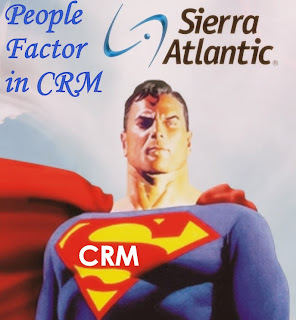
Dears,
More than a decade I’ve suggested this mix for a successful CRM initiative:
More than a decade I’ve suggested this mix for a successful CRM initiative:
People (50 percent), Process (30 percent), and Technology (20 percent):
and still organizations often fail to devote the time and resources needed to address the inevitable people issues that come up. This shortcoming can lead to a less-than-optimal (or even failed) CRM implementation.
Every company needs to perform a regular CRM assessment. Think of it as your annual corporate physical. (See my earlier blog CRM Assessment) In each of the last three CRM assessments conducted (For Confidentiality purpose I am siting the examples which are outside my official sphere but heard about it from my ex colleagues), the “people” component was the core reason that a CRM initiative was performing below expectations.
First assessment was with a global venture-capital firm .In addition to a faulty software implementation, the firm had lost its executive sponsor and failed to properly train its CRM user base. The result: User-adoption rates had peaked at around 30 percent.
The next CRM assessment—at a pharmaceutical manufacturer—also involved a lost executive sponsor and improper training of CRM users. In this case, however, a less-than-optimal service process for customer incident management led to strong customer service rep resistance that threatened to kill the CRM initiative.
The third and recent CRM assessment—regarding the utilization of sales pipeline management within a Fortune 50 global services company—managers “talked the talk” but were not committed to using pipeline management reports generated from their CRM application to properly coach subordinates. As one sales rep said, “What interests my boss fascinates me, but if my boss isn’t interested I’m not going to bother documenting my sales leads.” The impact: User adoption at this company continues to remain well below where it should be.
In all three initiatives, the “people” issue negatively impacted success. You can address these issues before they become problems with the following six tips:
Every company needs to perform a regular CRM assessment. Think of it as your annual corporate physical. (See my earlier blog CRM Assessment) In each of the last three CRM assessments conducted (For Confidentiality purpose I am siting the examples which are outside my official sphere but heard about it from my ex colleagues), the “people” component was the core reason that a CRM initiative was performing below expectations.
First assessment was with a global venture-capital firm .In addition to a faulty software implementation, the firm had lost its executive sponsor and failed to properly train its CRM user base. The result: User-adoption rates had peaked at around 30 percent.
The next CRM assessment—at a pharmaceutical manufacturer—also involved a lost executive sponsor and improper training of CRM users. In this case, however, a less-than-optimal service process for customer incident management led to strong customer service rep resistance that threatened to kill the CRM initiative.
The third and recent CRM assessment—regarding the utilization of sales pipeline management within a Fortune 50 global services company—managers “talked the talk” but were not committed to using pipeline management reports generated from their CRM application to properly coach subordinates. As one sales rep said, “What interests my boss fascinates me, but if my boss isn’t interested I’m not going to bother documenting my sales leads.” The impact: User adoption at this company continues to remain well below where it should be.
In all three initiatives, the “people” issue negatively impacted success. You can address these issues before they become problems with the following six tips:
Secure your executive sponsor. This individual should be as high up in the organization as possible: the chief executive officer or managing director (or one of their direct reports). The executive sponsor must not only help clear roadblocks but also participate in the CRM initiative (e.g., insist that customer-facing issues get resolved utilizing information contained in the CRM system).
Create a meaningful governance structure. This will vary depending on your organization, but should at all times consist of the executive sponsor, the CRM project/program lead, and at least one subject-matter expert in each of the people, process, and technology segments. Governance meetings should take place at least quarterly.
Training Excellence.. CRM processes and tools are not intuitive. Asking users how intuitive they find these elements can be an eye-opening exercise. Instruction must include business process training for key customer-facing processes, CRM application training, remedial application training, and new-hire training. Where possible, leverage learning management tools to fulfill your CRM training needs.
Communicate effectively and often. Inform CRM users of any relevant activities they’ll be involved in (e.g., process enhancement), and promote your CRM success either in a written format (e.g., internal newsletter) or orally (e.g., meetings where successful CRM efforts get recognized).
Provide incentives and rewards. “CRM is a part of their jobs,” some executives will argue, “so why offer incentives and rewards to use it?” The reality is that small tokens of appreciation (financial or otherwise) significantly help secure long-term user adoption.
Implement meaningful stewardship. Ensure the effective utilization of CRM tools and techniques (e.g., sales managers should coach their sales reps based on insights gathered from the CRM system).
These six “must-dos” will help you secure the “people” component of the people/process/technology mix.
Your P&C
DC*

Thanks for your details and explanations..I want more information from your side..I Am working in cloud crm company in chennaishould you need for any other clarification please call in this number.044-6565 6523.
ReplyDelete